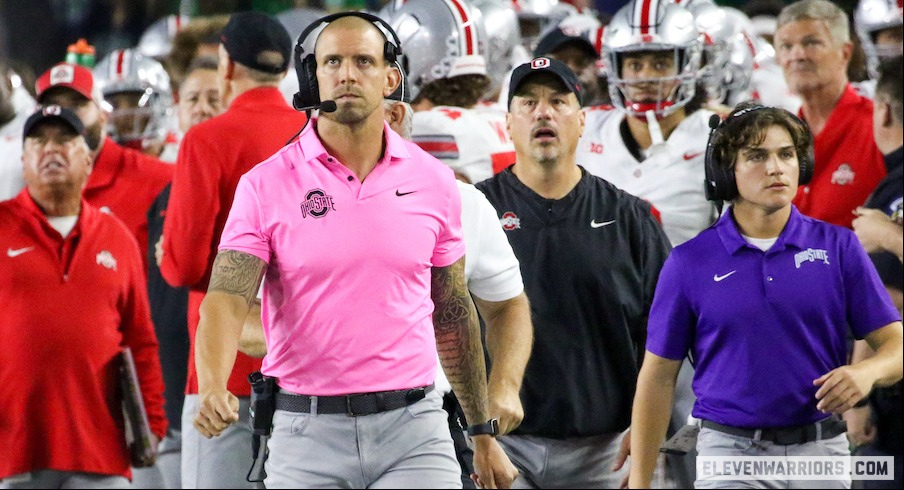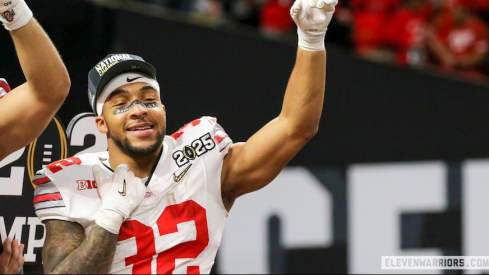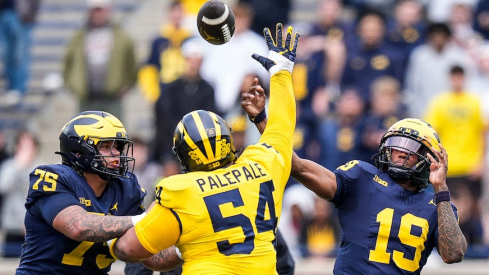As college football moves toward allowing teams to use helmet communications in games, new Ohio State linebackers coach James Laurinaitis knows firsthand how that could make it easier for coaches and players to communicate during games.
During his NFL career, Laurinaitis often wore the “green dot” helmet as the middle linebacker for the St. Louis Rams, allowing him to receive direct communication from the coaches on the sideline. He believes it will be a good thing for college football if helmet communication is implemented.
“I love the helmet speakers,” Laurinaitis said Tuesday.
Laurinaitis learned the hard way in his two years as a graduate assistant at Notre Dame and Ohio State how challenging it can be for coaches to have to signal in plays from the sideline. Teams typically rely on their support staffers to handle that responsibility, and Laurinaitis said he spent much of his time last year helping the Buckeyes change their signals from week to week in an effort to combat opponents’ sign-stealing efforts – a job that garnered increased focus last season amid the NCAA’s investigation into Michigan’s sign-stealing operation.
One of the biggest reasons why Laurinaitis is excited about his promotion to linebackers coach is that he’ll now be able to focus on coaching his position group during games rather than sending in signals.
“That’s stressful, man,” Laurinaitis said. “And obviously, for big reason, with a lot of the well-publicized stuff that kind of went on around signaling in our conference, I think it's very stressful … I mean, you're talking about week after week, changing signals, that took up a lot of your time. You became an expert in sign language sometimes with some of these calls.
“When I'm signaling, I'm sitting there waiting for what (defensive coordinator Jim Knowles is) gonna call next. Where I didn't have time to digest what was the last, what happened on that play, right? You kind of had to separate coaching and signaling. Where I think now just being able to coach, I’ll have a lot better pulse on ‘OK, what are the plays that are actually happening?’ Because that's a lot to handle, when it's going on and you had to have three, sometimes we had five signalers up and trying to confuse people on who's active, who's not.”
Such diversions could become less necessary if the NCAA approves the use of helmet communications in games this season. The Athletic’s Chris Vannini reported last week that the NCAA Football Rules Committee is expected to develop proposals at its meeting this month that would allow teams to use both helmet communication and sideline tablets during games.
The NCAA allowed teams to use helmet communication in non-playoff bowl games this past season as a trial run, and that trial was considered to be a success. Although Ohio State and Missouri mutually agreed not to use the technology in the Cotton Bowl, Ryan Day indicated at the time that he was in favor of implementing helmet communication for the 2024 season.
“Down the road, it makes a lot of sense,” Day said before the Cotton Bowl. “To try to manage a game without having done it all season, we felt like it was probably something we wanted to have a spring practice and a preseason to work through.”
As of now, it remains unclear how many players would be allowed to use the helmets at a time if helmet communication is approved. The NFL currently only allows the quarterback and one defensive player to have speakers in their helmets; assuming the NCAA adopts similar limits, the introduction of helmet communication wouldn’t eliminate the need for signaling, especially in up-tempo situations.
It could nevertheless help coaches communicate with their players more efficiently and help curtail sign stealing by opponents, which is why many coaches – including Ohio State’s newest assistant – are in favor of bringing the technology to the college game.
“You’re still gonna have to have signals because of the tempo, and you can imagine in the Shoe, if the crowd’s getting into it and it's second down and they go tempo on third down, you can communicate it in,” Laurinaitis said. “Now it depends on is it just the Mike linebacker or are they gonna let the whole defense have them? A lot of that has to be ironed out. Because in the NFL, it's a green dot, it's one guy. So you (the player with the helmet) would get the call and it would be on you to signal it or yell it to everybody else on the defense.
“I know during the bowl games, some of the teams had it where the whole defense would have the mic. That would be a dream, just because it would prevent obviously a lot of the sign stealing and stuff that happens.”


